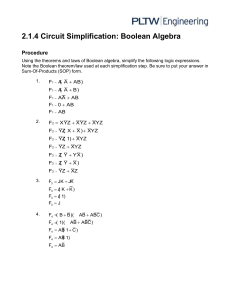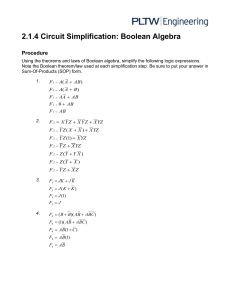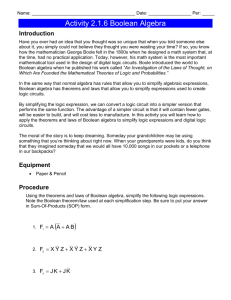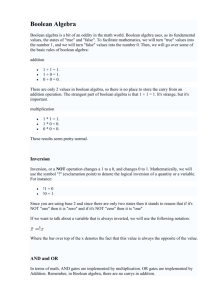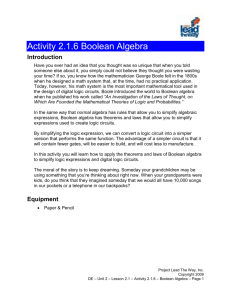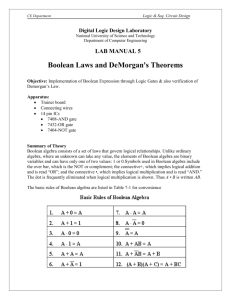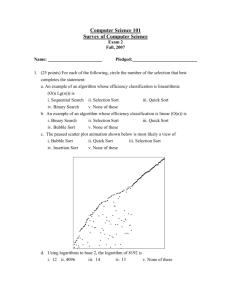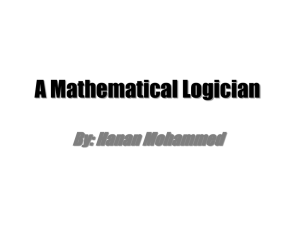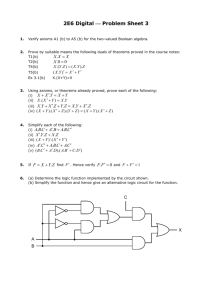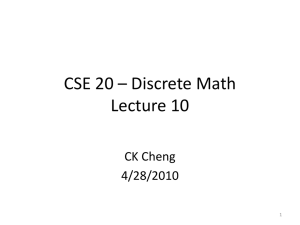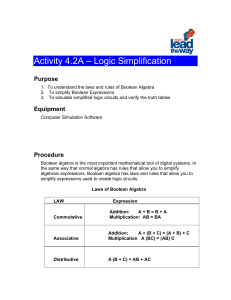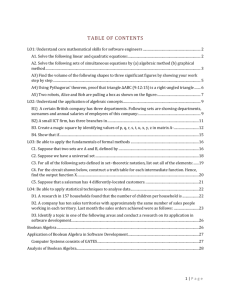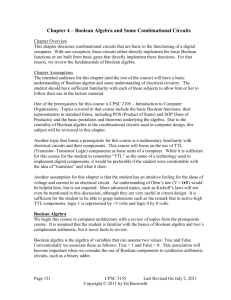activity 2.1.4
advertisement
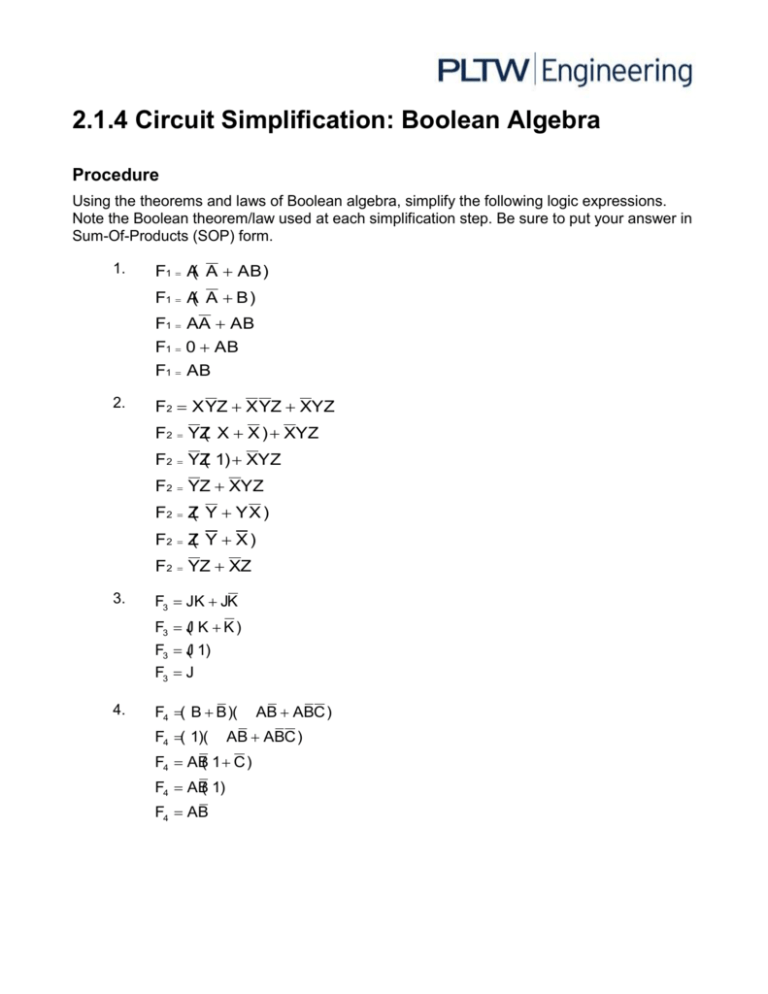
2.1.4 Circuit Simplification: Boolean Algebra Procedure Using the theorems and laws of Boolean algebra, simplify the following logic expressions. Note the Boolean theorem/law used at each simplification step. Be sure to put your answer in Sum-Of-Products (SOP) form. 1. F1 A( A AB ) F1 A( A B ) F1 AA AB F1 0 AB F1 AB 2. F2 X YZ X YZ XYZ F2 YZ( X X ) XYZ F2 YZ( 1) XYZ F2 YZ XYZ F2 Z( Y Y X ) F2 Z( Y X ) F2 YZ XZ 3. F3 JK JK F3 J( K K ) F3 J( 1) F3 J 4. F4 ( B B )( F4 ( 1)( AB ABC ) F4 AB( 1 C ) F4 AB( 1) F4 AB AB ABC ) 5. F5 ( X Y )( X Y) F5 XX XY X Y YY F5 X XY X Y 0 F5 X X( Y Y ) F5 X X( 1) F5 X X F5 X 6. F6 JK ( J K )L JK F6 JK JL KL JK F6 JK JL KL F6 JK JL ( K K ) KL F6 JK JKL JKL KL F6 JK JKL KL ( J 1) F6 JK JKL KL ( 1) F6 JK JKL KL F6 K ( J JL ) KL F6 K ( J L ) KL F6 JK KL KL F6 JK L ( K K) F6 JK L ( 1) F6 JK L An alternative solution for #6 utilizing DeMorgan’s theorem is shown below. Your teacher may wish to spiral back to this exercise. F6 JK ( J K )L JK F6 JK JK ( JK )L F6 JK ( JK )L F6 JK L 7. F7 RS R( S T ) S( S U ) F7 RS RS RT SS SU F7 RS RT 0 SU F7 RS RT SU 8. F8 ( N NM )( F8 ( N M )( N NM )( N M )( N M) N M) F8 ( NN NM NM MM )( F8 ( 0 MN MN M )( F8 ( M MN MN )( F8 ( M MN )( F8 ( M )( N M) N M) N M) N M) N M) F8 MN MM F8 MN M F8 M Almost as important as being able to use the laws of Boolean algebra (i.e., associative, commutative, or distributive) to simplify logic expressions, it is also critical that you are able to identify them. Identify the law of Boolean algebra upon which the following equalities are based. 9. AB A C BC A C BC AB Commutative 10. D EF G D E F G Associative 11. R S T U R S T U Associative 12. J KL M J L J M K L K M Distributive 13. R S T S V R S T R S V Distributive Now that you’ve practiced simplifying logic expressions, apply your knowledge to simplifying an actual circuit. 14. Shown below is a VERY poorly designed AOI circuit that is part of a coffee vending machine. Write the UN-SIMPLIFIED logic expression for the output Brew. 15. Using the theorems and laws of Boolean algebra, simplify the logic expression Brew Cut Off. Be sure to put your answer in Sum-Of-Products (SOP) form. BrewCutOff ( P( TP W ) T ) TP BrewCutOff TPP PW T TP BrewCutOff 0 PW T BrewCutOff PW T 16. In the space provided, draw an AOI circuit that implements the simplified logic expression Brew Cut Off. For your implement, assume that only 2-input AND gates (74LS08), 2-input OR gates (74LS32), and inverters (74LS04) are available. Draw this circuit in the space provided. If the temperature is too high (above 205 degrees F) or the pressure is not below the safe value (15 Bar) with enough water present (2 cups), the brew sensor cuts off the brew process. Brew Cut Off Circuit Conclusion 1. Describe the process that you would use to simplify a logic expression using Boolean algebra. Use Boolean algebra to organize/group similar terms. Then use Boolean algebra to simplify. 2. How do you know when you are finished simplifying and have arrived at the simplest equation? There are no Boolean theorems left to make the expression more condensed. 3. Other than using Boolean algebra, how could you prove that two circuits are equivalent? Compare the truth tables. 4. If you worked for a company that manufactured the coffee vending machine that used the poorly designed circuit, how much money would your new design save the company annually if each GATE cost 15¢ and the company made 500,000 vending machines per year? You would save the company $300,000 annually.
